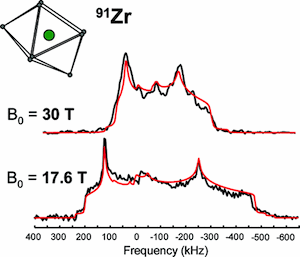Ask for a reprint
email :
* Give your email
2009
ACL
|
O.Pauvert, F.Fayon, A.Rakhmatullin, S.Krämer, M.Horvatić, D.Avignant, C.Berthier, M.Deschamps, D.Massiot, C.Bessada, '91Zr Nuclear Magnetic Resonance spectroscopy of solid zirconium halides at high magnetic field', Inorg. Chem. 48 8709-8717 (2009) doi:10.1021/ic9007119
91Zr solid-state NMR spectra of zirconium halides and several fluorozirconates have been obtained at high magnetic fields up to 30 T using both the Hahn-Echo and the Quadrupolar Carr−Purcell−Meiboom−Gill sequences combined with the broadband Variable Offset Cumulative Spectrum technique. For the zirconium halides, the 91Zr isotropic chemical shift covers a range of about 2000 ppm and shows a good correlation with Pauling’s electronegativity and ionic potential of the halogen. For the fluorozirconate samples, in which the Zr atoms exhibit various coordination polyhedra, increasing the Zr coordination number and the mean Zr−F bond length leads to an increased isotropic shielding. In the studied compounds the 91Zr quadrupolar coupling constants (CQ's) range from 10.6 to 44.7 MHz. For 6-fold coordinated Zr sites, a correlation between CQ and the shear strain of the octahedron is observed, and we investigate the relationship between the CQ and the distortion of the polyhedron for 8-fold coordinated Zr sites using different distortion criteria.
|

|